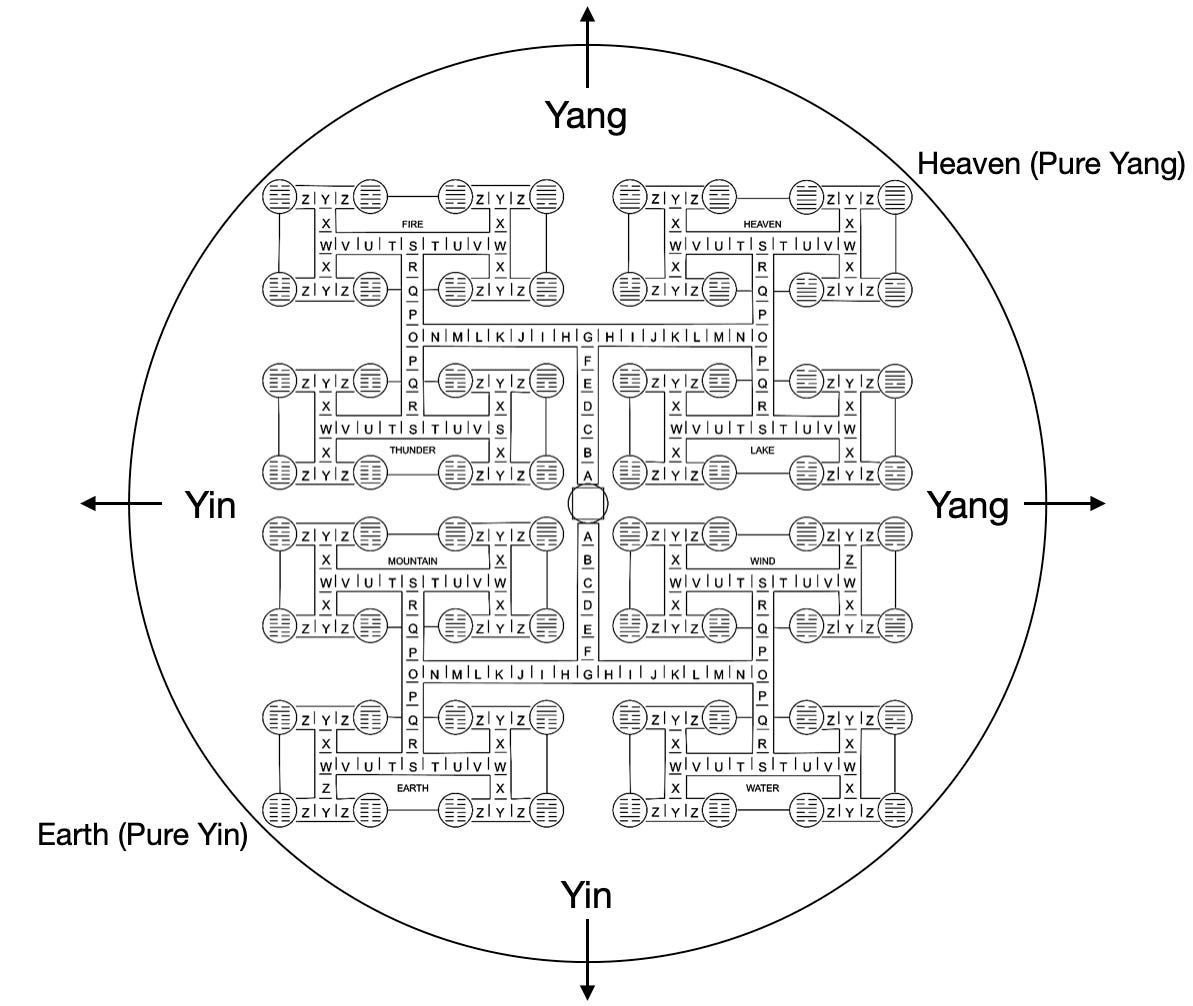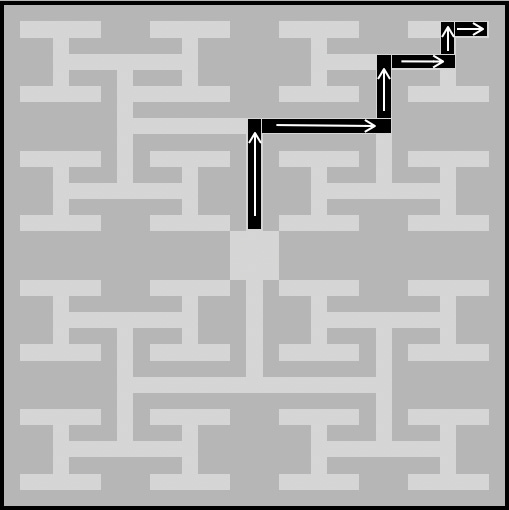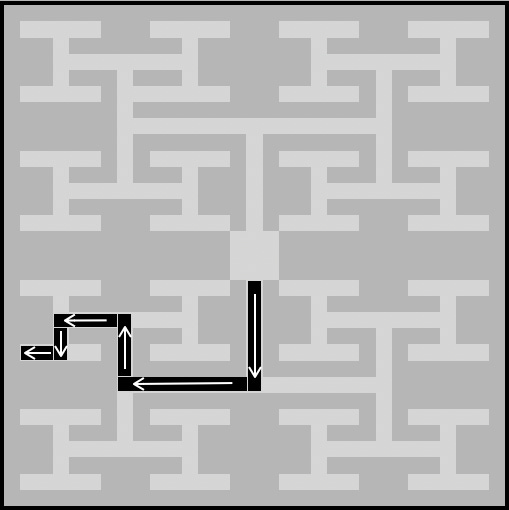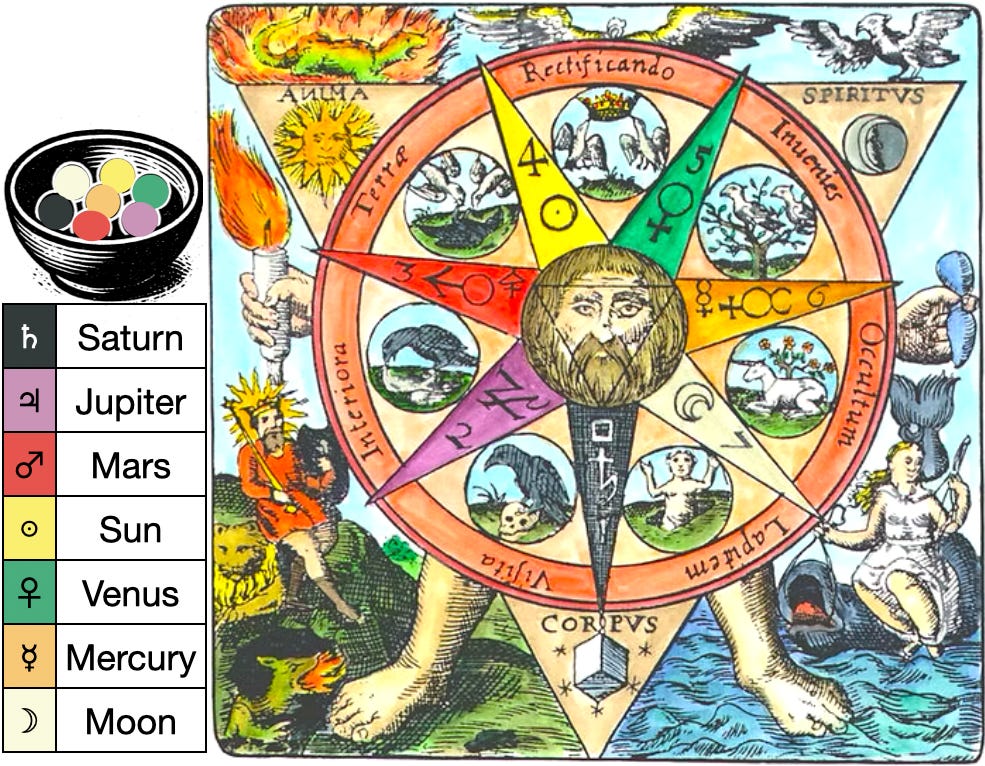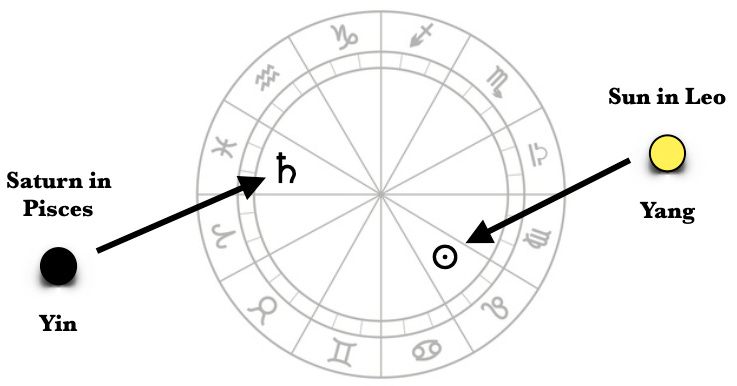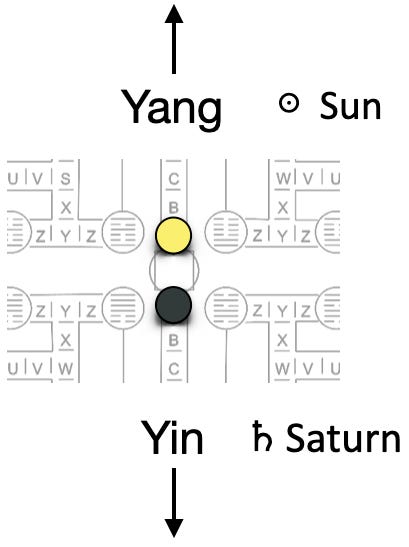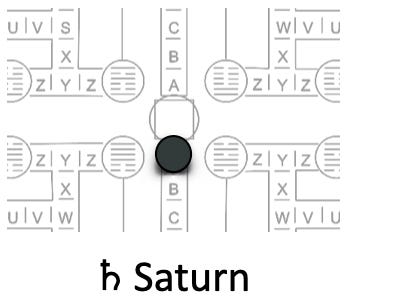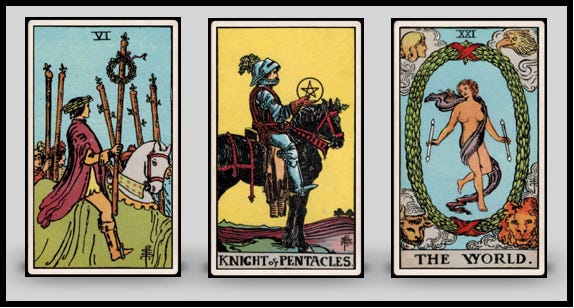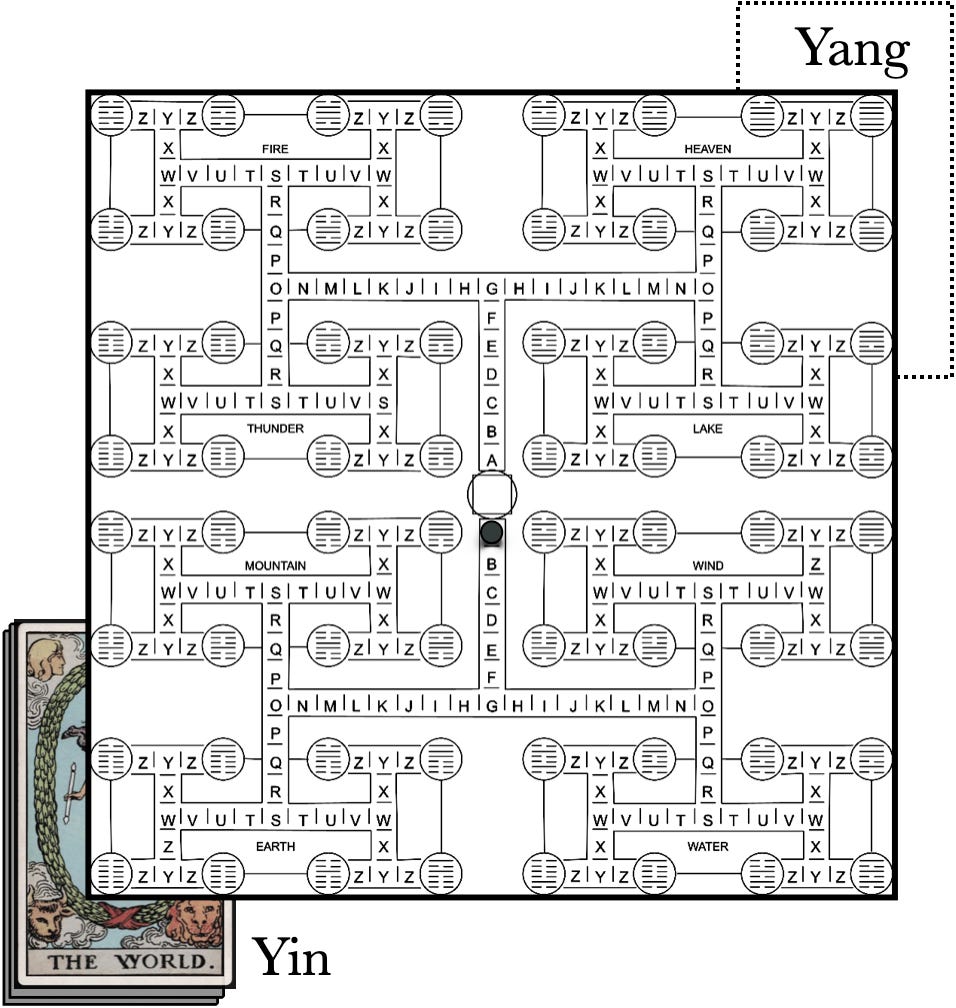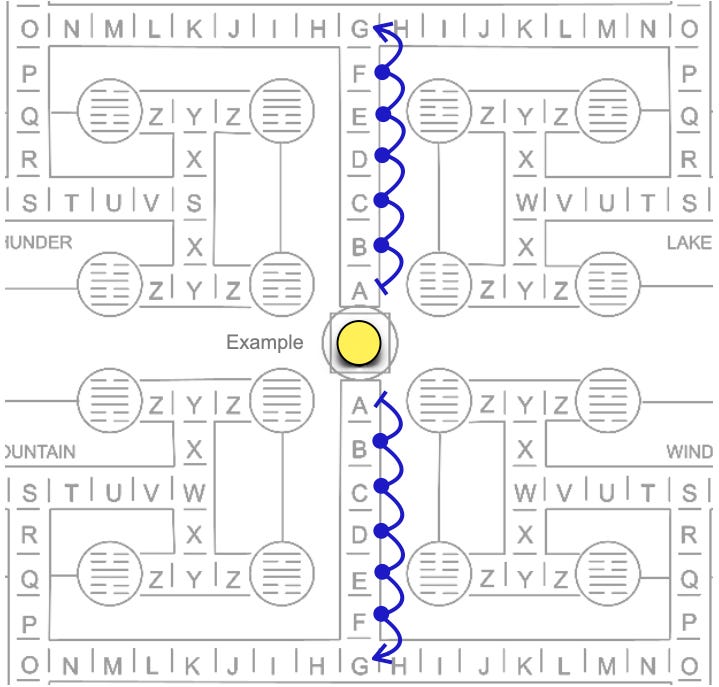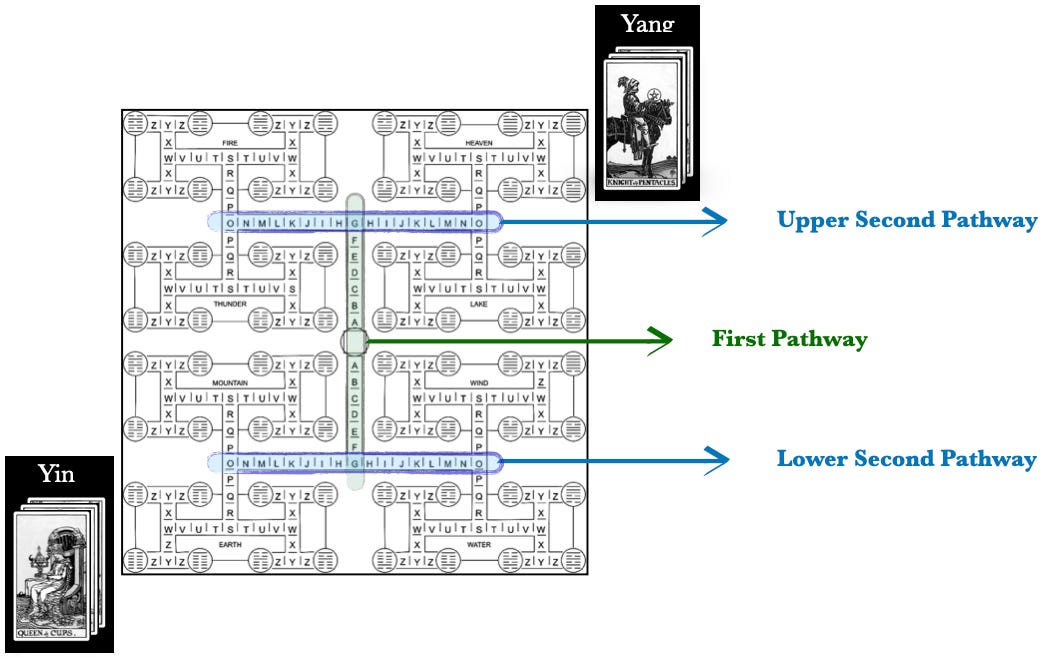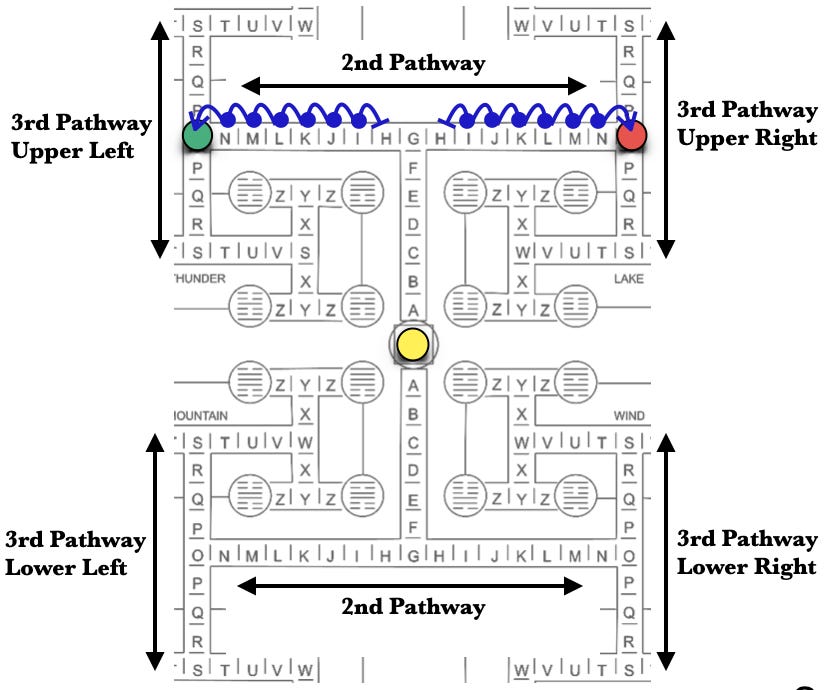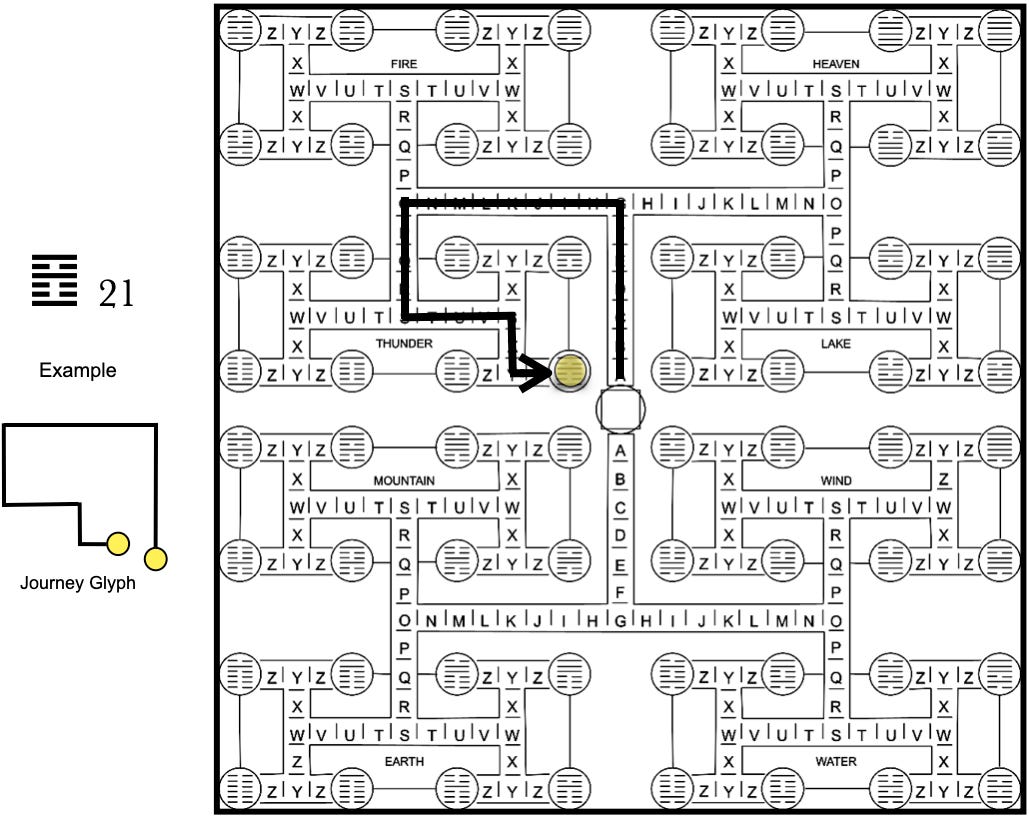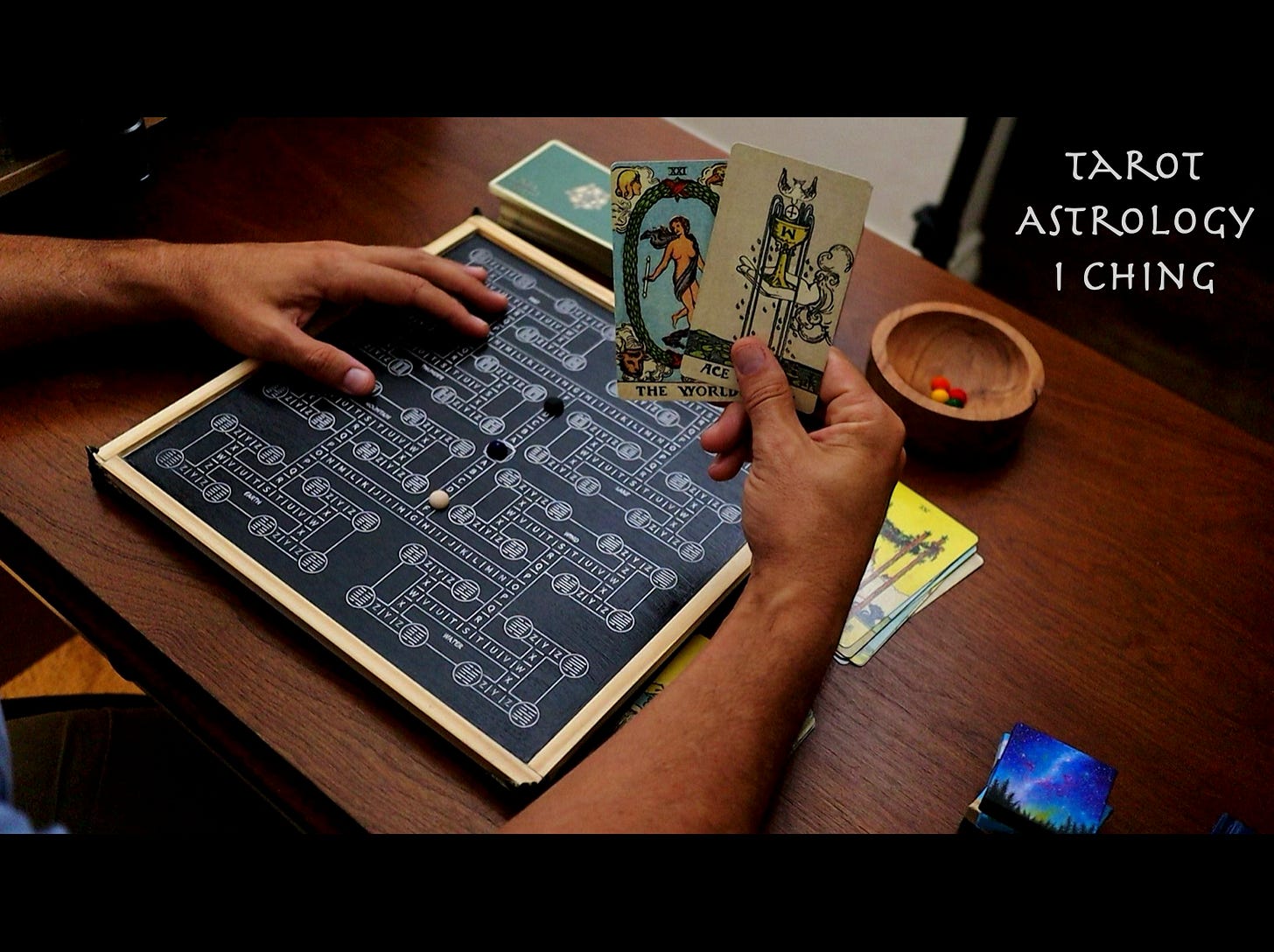The Hexatetraglyph Guidebook
How to embark on a 27-Day Psychological & Spiritual Journey using Astrology, Tarot & the I Ching.
The Hexatetraglyph has a design that often can be mistaken for a board game. However, for those embarking on a journey of self-discovery, it holds a deeper significance: it serves as a symbolic map and a sacred space. This oracle board actually represent the vast terrain of the inner world. Rather than physically walking thousands of steps to a holy site, here the seeker traverses a challenging path through spirit, psyche and soul.
The name “Hexatetraglyph” refers to the six pathways (hexa) and the four directions (tetra) seekers must traverse to reach one of the 64 possible destinations on the oracle map. Each endpoint corresponds to a hexagram from the ancient Chinese oracle, the I Ching (glyph)
What to Expect:
Tarot and Astrology (Day 1 - 26): Each day, a current astrological chart is consulted to generate a personal journal topic. Once a topic is chosen, the seeker performs a tarot reading to gain insights into the topic. This process involves drawing three cards daily for 26 days, ensuring that every card in the deck is encountered (26 x 3 = 78).
I Ching (Day 27): Daily movement eventually leads the seeker to one of the 64 potential endpoints. On the final day, the I Ching is consulted based on the destination reached, completing the process.
The Hexatetraglyph assists seekers focus on the following:
Daily journaling promotes self-reflection and introspection.
Comprehensive tarot reading offers a deeper understanding of the inner self and life’s archetypal patterns.
Synchronizing with astrological cycles aligns life with the universe’s natural rhythms.
Shadow work uncovers psychological defense mechanisms and unintegrated aspects of the unconscious.
Individuation leads to a deeper understanding of one’s “telos” and place in the world.
What is required:
Hexatetraglyph Oracle Board: This handcrafted balsa wood board, featuring a simple and elegant design, can be purchased online. It stands on four brass legs and includes seven hand-dyed wood game tokens for use with the system. Alternatively, you can print a copy for personal use. However, as the creator of this project, I kindly request that you refrain from selling the item if you decide to print a personal copy for free.
Tarot Cards Deck (78 Cards): In order to stay on schedule, the decks requires 78 cards. Any deck with strong archetypal images throughout should be suitable. Decks without a fully illustrated minor arcana may not be as effective. I personally suggest starting with the Rider Waite Smith tarot.
Journal or Notebook: Ensure the journal or notebook has at least 27 pages of space to write about various topics. If you prefer using a computer, that works just as well.
Astrological Chart (Current): Each day, you will study a fresh astrological chart. I typically refer to this website each morning. However, there are many other options, and it doesn’t matter whether you prefer a tropical or sidereal system. The Hexatetraglyph accommodates various traditions.
I Ching: There are many printed translations of the book, and you can also use an online version. Personally, I recommend studying multiple sources once you receive a hexagram.
Quiet Space where you can focus for about an hour each day for 27 consecutive days. (If the journey takes you longer that 27 days, that’s alright too.)
Elementary Understanding of tarot, astrology and the I Ching.
Right Attitude. When you face your flaws, resist the urge to deny them. When you hear the voice of your conscience or daimōnion, make an effort to listen attentively. If you are not ready to do these things, you may be wasting your time.
Getting your Bearings:
Two positions near the center of the Hexatetraglyph are marked with the letter A. On the first day, you’ll place a game token on both of these positions. This action marks the beginning of the journey.
From there, it is by following outward along branching pathways that will lead you to a terminal position or endpoint. Regardless of how you travel the fractal pattern, you will reach one of 64 possible endpoints on the 27th day of the journey. Whichever of these terminal positions you arrive at, it will be marked with an I Ching hexagram.
Movement towards the upper side and right side of the board is considered yang. Movement towards the lower or left side of the board is considered yin. For this reason, Hexagram #1 is located at the far right-upper corner of the board. Hexagram #2 is located on the far left-lower corner.
If you trace a line from board position A to any of the 64 endpoints, you will notice the direction one travels determines the hexagram one receives. For instance, if you travel only up (yang) and only right (right), the result would be ䷀ Hexagram 1. Notice there are six yang lines which correlate with completing six yang pathways.
Now let’s look at a more complex set of movements to discover what happens. For example, if you were to travel down (yin) on the first pathway, left (yin) on the second, up (yang) on the third, left (yin) on the fourth, left (yin) on the fifth, and left (yin) on the sixth, then the result would be ䷎ Hexagram 15. Notice this time there is only one yang line (the third), and the rest are yin. With that, you can now see how hexagrams reflect the way in which one moves across the map.
Day 1 (Position A):
Access an astrological website (of your preference) to familiarize yourself with the planets’ current positions within the zodiac.
Place your seven game tokens in a small bowl or bag.
With eyes closed, reach in and randomly draw two tokens.
Note: Planetary tokens represent the seven classical planets of astrology. Each day, you will seek inspiration from one of these planets.
After analyzing the current astrological chart, you must make a crucial decision. One of the planetary tokens better symbolizes yin energy, while the other better symbolizes yang energy. Now, it’s up to you to classify each of these two tokens. Choose which token better symbolizes yin and which better symbolizes yang. (See Yin-Yang Theory)
Note: Classifying the tokens requires you to weigh the qualities of the planets and the signs they are transiting. It’s okay to take a moment to ponder the interaction of the planets and the zodiac signs; but remember, this is a subjective classifying exercise. There are no wrong answers here! It’s encouraged that you trust your gut feeling. This step might feel awkward at times—that’s good! Classifying the energy of planets is meant to provide you with a small challenge.
Now that you have classified the two planetary tokens, place the yang token on the upper A position and the yin token on the lower A position.
Each day you will focus on the symbolism of a single planet. Consider which of the two available planets might be beneficial in developing a journaling topic for that day. Choose the planet that you believe would be most helpful.
Once you’ve picked your planet, take a moment to contemplate its symbolism, including the zodiac sign it resides in. When you’re ready, use that astrological framework (Planet+Sign) to inspire a topic idea for your personal journal.
Example: If you were to work with Saturn in the sign of Pisces, you might jot down some dreams or fantasies (inspired by Pisces). Subsequently, you could delve into how taking practical steps (inspired by Saturn) could help make these mere wishes a tangible reality.
With a well-crafted topic written in your journal, it’s now time to consult the tarot.
Each day a three-card draw is used. You might prefer a structured spread or a more spontaneous approach. Either way works well. The important part is that you decide on a reading method before drawing any cards.
Take a moment and define your method for interpreting the cards: Would you like to use a fixed three-card spread? Or, would you rather take a more open approach—simply relying on intuition and your innate pattern recognition capabilities? If you opt to use a spread, ensure you define a specific meaning for each card position.
Keep in mind, the tarot reading is simply intended to help you approach your personal journal topic.
When you feel ready, draw three cards from a shuffled deck.
Examine the three cards and let their images stimulate your intuition and imagination. This is a chance to practice free association. You might also create a narrative based on the card’s symbolism. Regardless of your chosen approach to card reading, the key here is that you incorporate tarot into your daily personal journaling practice.
Example: If Saturn in Pisces were inspiring you, the journal entry could reflect that energy with a topic like, “How should I methodically approach a dream or fantasy to make it a tangible reality?”
The card reading might go like this:
Card 1: Six of Wands - I need to focus on visualizing real success and victory.
Card 2: Knight of Pentacles - I need to create repeatable actions to form lasting habits.
Card 3: The World - To make my dream come true, I must master other aspects of my life. It’s time to see the bigger picture, including my mind, body, spirit, and soul.
Take plenty of time to write.
When you have finished, the three cards will not be returned to the deck. Instead, place them under the Hexatetraglyph. If you have been working with a yin planet, set the cards under the bottom left corner of the board. If you have been working with a yang planet, place the cards under the top right corner of the board.
Example: Working with Saturn in Pisces, the planet was classified as yin. Therefore, the three cards are considered yin and placed under the bottom left corner of the board.
There is a unique step that happens at the conclusion of Day One. This only happens once throughout the entire 27-day process. It is simple, but important!
Only on Day One: The planetary token you did not choose to work with is placed on the central position of the Hexatetraglyph. Throughout the journey it will keep the same polarity it was assigned on day one. For instance, if you originally classified it as yin, then it will remain yin throughout.
The game token on the center position may be used as a tiebreaker under certain circumstances. This will be covered later in the Guidebook.
Day 2 (Position B)
Leave the tiebreaker token at the center of the Hexatetraglyph.
Place the other six planetary tokens in a bowl or bag—and with eyes closed, draw two of them.
Locate the two planets on a current astrological chart.
Subjectively classify the two planets: One better symbolizes yin energy. One better symbolizes yang energy.
Place the yin token on the lower B position. Place the yang token on the upper B position. (Do not replace the tiebreaker token.)
Select which planet you would like to work and return the other token back to the bowl or bag.
Study and ponder the astrological symbolism, then use the planet + zodiac sign to inspire a journaling topic.
Decide on you method for using the tarot (defined spread or freestyle), then draw three cards to help you explore your journaling topic.
Write in your journal.
Place the three tarot cards under the Hexatetraglyph board. If you worked with a yin planet, place them under the bottom left corner. If you worked with a yang planet, place them under the top right corner.
Days 3 - 6 (Positions C-F)
You’ve now grasped the fundamentals! Simply repeat the same process at each position along Pathway 1 (until you reach position G).
Day 7 (Position G)
Today, you’ll complete the first pathway. The process remains the same, but you’ll need to make a judgment once you’ve finished writing your journal entry.
Note: You have now worked with 21 tarot cards. All the cards you have seen should be placed beneath the Hexatetraglyph board. The Yin cards are positioned at the bottom left corner, while the Yang cards are at the top right corner.
Determine the number of yin cards you have collected. Then, determine the number of yang cards you have collected.
Compare the two quantities of cards and determine if you collected a greater number of yin or yang cards.
If you have a greater number of yin cards, tomorrow you will move along the lower second pathway.
If you have a greater number of yang cards, tomorrow you will move along the upper second pathway.
Once you’ve realized which second pathway you will travel on, discard all 21 tarot cards you used on Pathway 1. Set them aside and avoid using them again during the rest of the journey.
On the second pathway you will create two new piles of cards under the bottom left and top right corners of the board.
How to Resolve a Tie
At positions G, O, S, W, Y and Z the yin and yang card piles are counted and compared. This is how to determine which pathway will be travelled next. Sometimes a tie happens, meaning the number of yin and yang cards are equal.
If a tie occurs, there is a planetary token at the center position of the Hexatetraglyph that can resolve the situation. The tiebreaker token holds a yin or a yang polarity. Remember, the polarity was determined on day one of the journey.
If the tiebreaker token holds a yin polarity, simply declare the tie has been broken in a yin direction. If the tiebreaker token holds a yang polarity, declare the tie is broken in the yang direction.
With the tie resolved, movement takes place in the typical manner.
Days 8 - 15 (Positions H-O)
Movement is now oriented along the horizontal axis. Aside from that, the second pathway is traveled using the same method as the first pathway.
On Day 15 (position O), after completing your journal entry, count the number of yin cards you have collected. Then, count the number of yang cards you have collected.
Compare the two quantities and determine if you collected a greater number of yin or yang cards.
If you have a greater number of yin cards, tomorrow you will travel along the third pathway on your left. If you have a greater number of yang cards, tomorrow you will travel along the third pathway on your right.
Remember, if there is a tie, the planetary token at the center of the Hexatetraglyph can resolve the situation.
Days 16 - 26 (Positions P-Z)
On Day 16, you will have reached position P on the third pathway.
Note: Take a moment to study the Hexatetraglyph. You’ll notice the board can be divided into four equal quadrants. Once you enter one of these quadrants (which you just did), only a quarter of the potential endpoints are still available to you. At the start, there were 64 possible endpoints; now, only 16 remain open.
Until you exhaust all the tarot cards (which occurs after completing position Z), the process remains consistent throughout the journey.
When you reach positions S, W, Y, and Z, you’ll compare the number of cards you’ve collected. The next pathway is always determined by the higher card count.
Yin Cards > Yang Cards = Take the pathway on the Lower or Left Side
Yang Cards > Yin Cards = Take the pathway on the Upper or Right Side
On Day 26 (position Z), you have a special opportunity. If you wish, you may remove the planetary token from the center of the Hexatetraglyph (Tiebreaker Token) and use it as one of the two planetary tokens drawn. This provides you with one final opportunity to integrate the planet that has remained inaccessible throughout the entire journey.
At position Z, the movement pattern you have grown used to becomes slightly The sixth pathway is unique because it only has one position, which is Z. Therefore, if you choose to work with the yin planet on the left, you’ll complete Pathway 6 and reach the hexagram to the left. Conversely, if you choose to work with the yang planet on the right, you’ll complete Pathway 6 at the hexagram to the right. In short, there is no need to count cards at the end of this pathway.
Day 27 (Hexagram Endpoint)
After completing position Z, you’ll finally reach one of the 64 endpoints. Congratulations!
During your symbolic pilgrimage to the oracle, the Moon has traveled through the entire zodiac and you have utilized all 78 cards in the tarot deck. The map you have walked across represents the I Ching—and now you have found your way to a hexagram.
To understand the significance of your hexagram, it’s wise to explore multiple translations of the I Ching. Approach the book as a holy text. Trust that over the coming days, synchronicity will reveal the true meaning.


